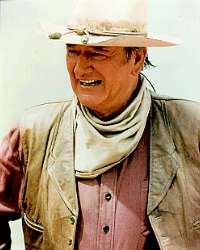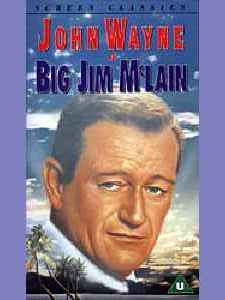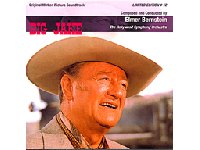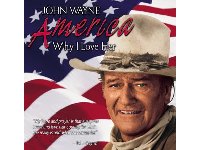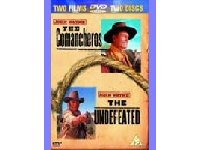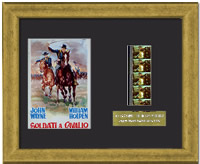|
|
Please visit our latest website for a more in depth John Wayne Biography www.johnwayneboxsets.co.uk
He has come to represent the archetypal American of the country's formative period: honest, direct, decisive, solitary, and reverent; one whose faith in his own ability enables him to take action when it's needed, and whose belief in justice spurs him to right wrongs when they're discovered.John Wayne, nicknamed "Duke," played that character or variations on it in almost every movie he made, and it became so much a part of him that most people couldn't separate the real Wayne from his screen persona.
Duke Morrison was a USC football player who often worked, as did many Southern California college students, for filmmakers as extras and/or grips. He can be spotted in several late 1920's silents, including Brown of Harvard (1926), The Drop Kick, Mother Macree (both 1927), Hangman's House and Four Sons (both 1928). Several of those were directed by John Ford, who gave Duke and his football pal Wardell Bond bit parts in his 1929 talkie Salute.Ford also recommended he be tested for the lead in Fox's upcoming Western epic The Big Trail to be directed by Raoul Walsh.Duke won the role, and his name was changed to John Wayne.Making the rugged frontier drama The Big Trail (1930) was an arduous experience for everybody, especially novice stars Wayne and Marguerite Churchill. It was also a flop at the box office, prompting Fox to drop him after he did a few minor programmes.He took bits wherever he could, supporting Western stars Buck Jones in 1931's Range Feud and Tim McCoy 1931's Texas Cyclone and 1932's Two Fisted Law and starring in three cheap but action-packed serials, The Shadow of the Eagle, The Hurricane Express (both 1932), and The Three Musketeers (1933).By the time those serials hit theaters, Duke had already landed a contract with Warner Bros., where he starred in six lowbudget Westerns, and got bit parts in such A-level features as The Life of Jimmy Dolan, Central Airport, College Coach and Baby Face (all 1933).Out in the cold again, he won the lead in a Poverty Row quickie, His Private Secretary then spent the next two years starring in B Westerns for Monogram Pictures. (The first, 1933's Riders of Destiny cast him as "Singin' Sandy," although his warbling was dubbed by the son of director Robert N. Bradbury.)He spent the rest of the 1930's headlining Westerns and grade-B action features, first for Republic and then for Universal.He returned to Republic in 1938 to replace Bob Livingston as Stony Burke in eight entries of the long-running "Three Mesquiteers" series, including Pals of the Saddle, Overland Stage Raiders (both 1938),
The Night Riders, Wyoming Outlaw and New Frontier (all 1939).Between "Mesquiteer" shoots, Wayne was called by his old friend John Ford to test for the leading role of the Ringo Kid in his groundbreaking "adult" Western Stagecoach (1939).After a decade in front of the camera, this film made him an "overnight" star. He remained eternally grateful to Ford.He continued to work out his contract at Republic, starring in B-plus vehicles at the studio, but he was also in demand, for the first time, as a leading man in Hollywood.He paired off with Marlene Dietrich and Randolph Scott in both The Spoilers and Pittsburgh, shared starring honors with Ray Milland and Paulette Goddard in Cecil B. DeMille's Reap the Wild Wind (all 1942), romanced Joan Crawford in Reunion in France (also 1942), Jean Arthur in A Lady Takes a Chance (1943), and Claudette Colbert in Without Reservations (1946).He also forged a lifelong association with war movies by starring in Flying Tigers (1942), The Fighting Seabees (1944), Back to Bataan and John Ford's They Were Expendable (both 1945).Ironically, he was exempt from military service in real life because of an ear infection developed during underwater shooting on Reap the Wild Wind.In 1948 Duke starred in Howard Hawks' Red River delivering an eye-opening performance as an unforgiving cattle baron who squares off against his adopted son (Montgomery Clift).For the first time, critics sat up and took notice.He continued to do impressive work in Ford's 3 Godfathers and Fort Apache (both 1948), the first of the director's cavalry trilogy.In 1949 Ford gave him one of his best roles, in She Wore a Yellow Ribbon as aged Capt. Nathan Brittles, who's slated to retire just as an Indian war is looming. Mustached and bespectacled, Wayne convinced audiences that his bones creaked every time he moved.That same year he made war movie history as the tough-as-nails Marine drill instructor (who has a heart, after all) in Sands of Iwo Jima (1949), which earned him his first Academy Award nomination.Ford and Wayne made one more Cavalry film, Rio Grande (1950), as a payback to Republic boss Herbert J. Yates; by turning out this surefire box-office film, they earned the right to make Ford's pet project, The Quiet Man.Wayne first encountered Maureen O'Hara onscreen in Rio Grande and it was immediately clear that they had a special chemistry. They reunited in The Quiet Man (1952), a charming, romanticised view of Ireland as seen by an American.
It was one of Wayne's most endearing performances, and one of the first that allowed audiences to enjoy his lighter side.When Wayne brought Ford to Republic, the star secured a promise from Yates to let him film the story of the Alamo, a longtime dream. Yates later reneged, and Wayne never worked on a Republic film again.Wayne formed his own production company, Batjac (the name of the shipping company in 1948's Wake of the Red Witch to develop projects both for him and for other stars. Having produced Budd Boetticher's Bullfighter and the Lady (1951) at Republic, he hired the director again for the Randolph Scott Western Seven Men From Now (1956).He also put strapping James Arness under personal contract, and recommended him to CBS for the lead in the "Gunsmoke" TV series, even introducing the first episode on camera.Wayne co-produced and starred in Big Jim McLain (1952), Island in the Sky, Hondo (both 1953), The High and the Mighty (1954), Blood Alley (1955), and Legend of the Lost (1957).He worked again with Ford on what many consider to be the finest of their collaborations, The Searchers (1956), with Duke as an avenging angel in pursuit of Indians who had murdered his family and kidnapped his niece.The two friends also teamed for The Wings of Eagles (1957), which cast Wayne as Navy aviator turned screenwriter "Spig" Wead, and The Horse Soldiers (1959), a Civil War story.Often accused of simply "playing himself" on screen, Wayne tried to stretch in the 1950's, but his choices were ill advised, to say the least, and both The Conqueror (1956, in which he played Genghis Khan) and The Barbarian and the Geisha (1958, in which he played 19th-century American ambassador Townsend Harris) were major fiascos.In the years to follow he stuck to the tried-and-true, and who can blame him? Audiences lined up to see a "John Wayne movie" and he gave them what they wanted.His last "personal" projects, which he directed and starred in, were the sprawling, extravagant super-production The Alamo (1960), in which he played Davy Crockett, and The Green Berets (1968), which reinforced his real-life image as a Hawk during the Vietnam era.These aside, Wayne continued working with Howard Hawks, in Rio Bravo (1959), the terrific African adventure Hatari! (1962), the Rio Bravo paraphrase El Dorado (1967), and Rio Lobo (1970), and John Ford in The Man Who Shot Liberty Valance one segment of How the West Was Won (both 1962, in the latter as Gen. William Tecumseh Sherman), and Donovan's Reef (1963). His son Michael took the producer's reins on McLintock! (1963), directed by onetime Ford assistant Andrew McLaglen, which reunited Wayne with Maureen O'Hara.He repeatedly surrounded himself with such friends and colleagues in his remaining films, giving such otherwise uninspired Westerns as The Sons of Katie Elder (1965), The War Wagon (1967), Chisum (1970), Big Jake (1971), The Train Robbers and Cahill United States Marshal (both 1973) a welcome feeling of continuity for his fans.True Grit (1969) gave him his first character role in years, as a boozy, one-eyed, over-the-hill lawman, and it won him his only Academy Award. He reprised the character in Rooster Cogburn (1975), a mediocre film distinguished by his genial performance opposite Katharine Hepburn, in an "odd couple" teaming meant to kindle thoughts of The African Queen.In later years Wayne appeared in a few non Western movies, even trying his hand at a more contemporary cop story (ê la Clint Eastwood): McQ (1974) was pretty embarrassing, but Brannigan (1975) at least had the novelty of putting brawny American Wayne in a London setting.The Shootist (1976) was a fitting valedictory to his career. The story of an aging gunfighter who learns he's dying of cancer, it featured a thoughtful, mature lead performance that suggested Wayne knew all too well the parallels between himself and his character.His last public appearance, at the 1979 Oscar ceremony, was itself an act of courage for the cancer-ridden star, who died just a few months later.His eldest son Michael produced many of his father's later films; another son, Patrick Wayne, had small parts in a number of his films and went on to a modest career as leading man in movies and television. A much younger son from a later marriage, John Ethan Wayne, launched an acting career of his own in the 1980's. Please visit our latest website for a more in depth John Wayne Biography www.johnwayneboxsets.co.uk.
|

